A 40-something Neanderthal woman named Shanidar Z was discovered buried in a cave in Iraqi Kurdistan in 2018. Scientists painstakingly reconstructed her skull from 200 bone fragments, guiding the reconstruction to understand what she may have looked like. The facial reconstruction suggests that Neanderthals may not have looked as different from Homo sapiens as previously thought, with large brow ridges and no chins. Shanidar Z is featured in a new documentary called “Secrets of the Neanderthals,” which is now available for streaming on Netflix.
Neanderthals lived across Europe, the Middle East, and Central Asia Mountains for around 300,000 years, overlapping with modern humans for 30,000 years. Analysis of DNA from present-day humans has shown that Neanderthals and Homo sapiens occasionally interbred. Shanidar cave, where Shanidar Z was found, has yielded the remains of more than 10 Neanderthals. The site was first excavated in the 1950s, and recent analysis has cast doubt on the theory that Neanderthals buried their dead with flowers, suggesting the pollen found was instead brought by pollinating bees.
The sex of Shanidar Z was determined for the first time using a sequencing technique of proteins inside tooth enamel, revealing that she was a woman of around 5 feet in height and in her mid-40s at the time of death. Despite being an archaeologically significant find, Shanidar Z is not the only Neanderthal discovered in the cave. During the documentary’s filming in 2022, more remains were uncovered, likely belonging to a single individual that had been disturbed over time.
Reconstructing Shanidar Z’s skull was described as a “high-stakes 3D jigsaw puzzle” by Dr. Emma Pomeroy, the paleoanthropologist who unearthed the skeleton. Over 200 bone fragments were pieced together to recreate Shanidar Z’s skull, which was then scanned and 3D printed for further analysis. Danish paleoartists Adrie and Alfons Kennis created a facial reconstruction of Shanidar Z for the documentary, providing a glimpse into what this ancient Neanderthal woman may have looked like. The reconstruction helps bridge the gap between anatomy and 75,000 years of time.
While the inhabitants of Shanidar Cave may not have buried their dead with flowers, they were likely an empathetic species, taking care of individuals with disabilities such as a deaf male with head trauma and a paralyzed arm. Despite the persistent image of Neanderthals as brutish and unintelligent, increasing evidence has shown their intelligence, sophistication, and complexity. Scientists continue to uncover new insights about these ancient humans through ongoing research and analysis of archaeological sites like Shanidar Cave.


